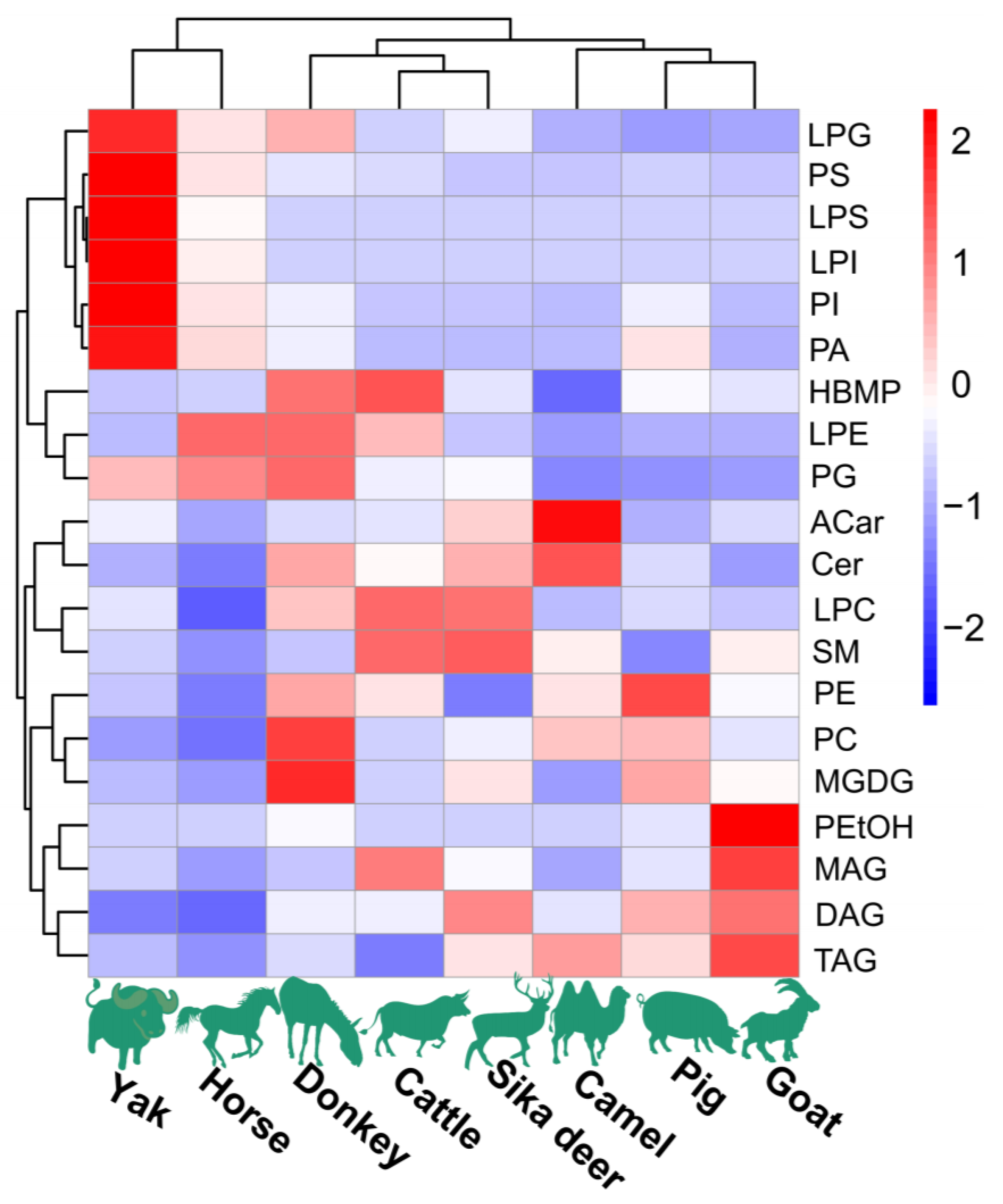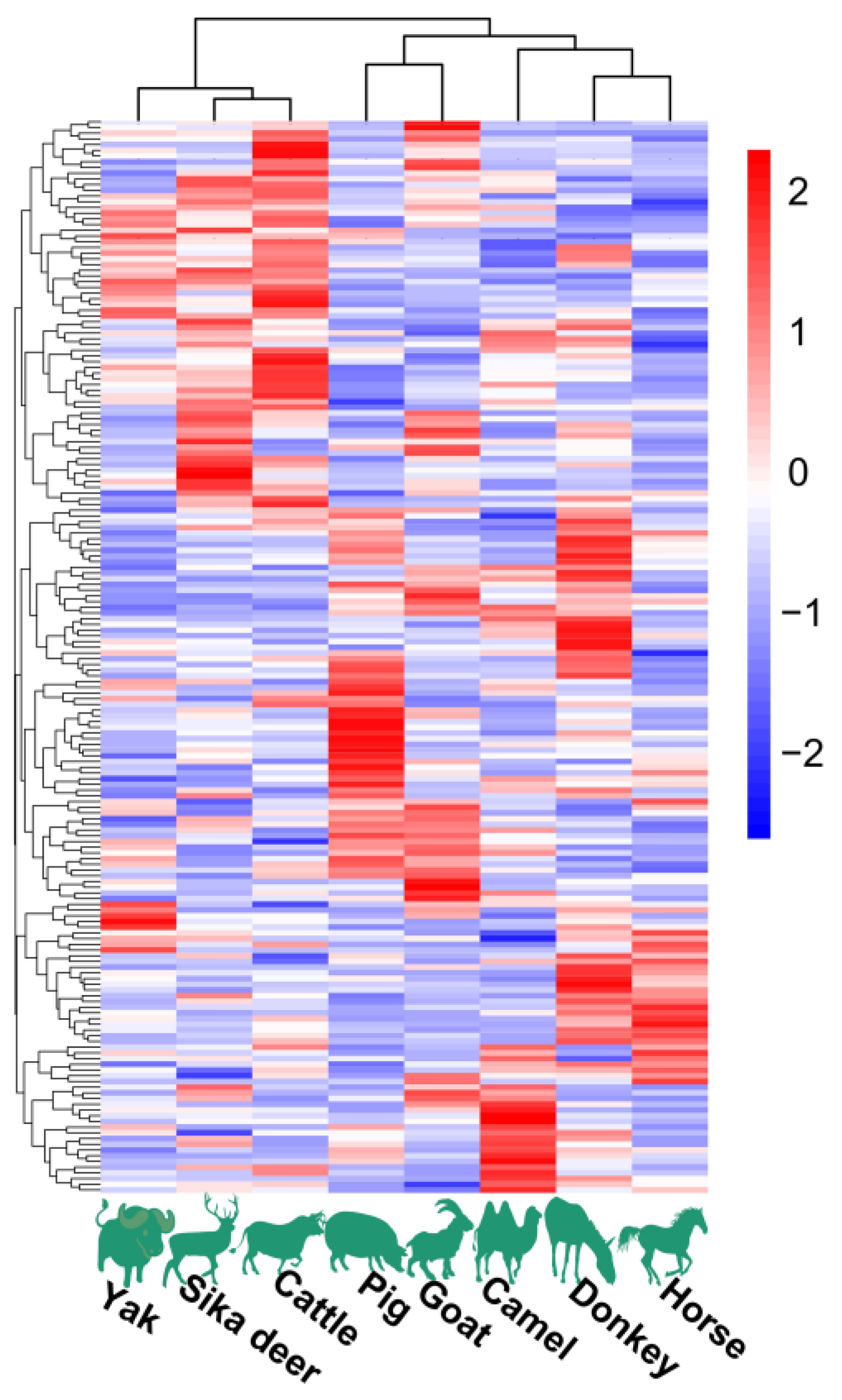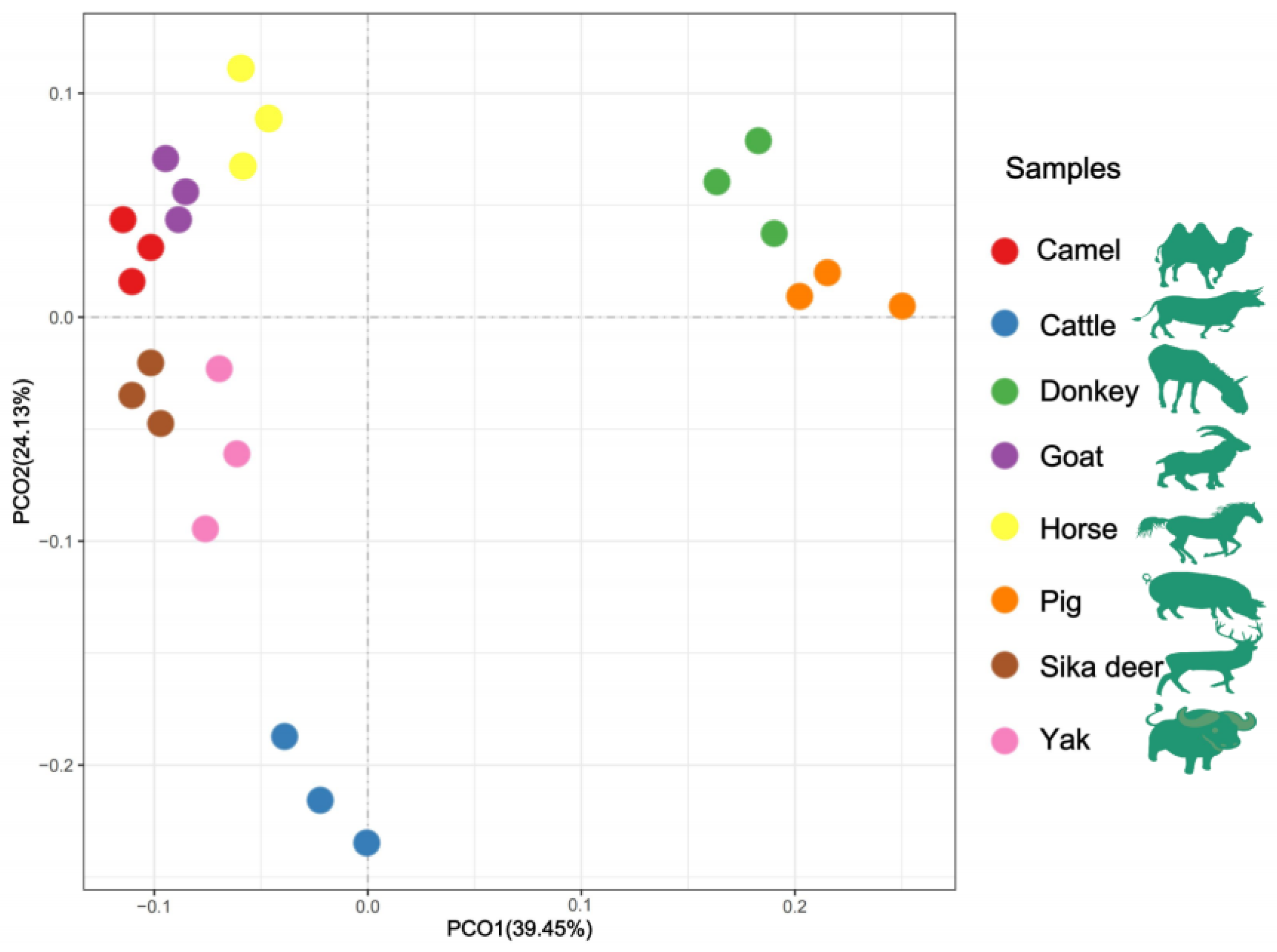UPLC-Q-Exactive Orbitrap-MS-Based Untargeted Lipidomic Analysis of Lipid Molecular Species in Spinal Cords from Different Domesticated Animals
Abstract
:1. Introduction
2. Materials and Methods
2.1. Samples and Chemicals
2.2. FA Composition Analysis
2.3. Lipidomic Analysis
2.4. Canonical Correlation Analysis (CCA)
2.5. Statistical Analysis
3. Results
3.1. FA Profiles of Spinal Cords from Eight Species of Domesticated Animals
3.2. Lipidomic Profiles of Spinal Cords from Eight Domesticated Animal Species
3.2.1. PL Profiles
3.2.2. SL Profiles
3.2.3. GL Profiles
3.2.4. ACar and MGDG Profiles
3.3. Correlation between Genomic Sequence and Lipidome
4. Discussion
5. Conclusions
Author Contributions
Funding
Data Availability Statement
Conflicts of Interest
Abbreviations
References
- Toldrá, F.; Mora, L.; Reig, M. New insights into meat by-product utilization. Meat Sci. 2016, 120, 54–59. [Google Scholar] [CrossRef] [PubMed]
- Palm, W.; Rodenfels, J. Understanding the role of lipids and lipoproteins in development. Development 2020, 147, dev186411. [Google Scholar] [CrossRef] [PubMed]
- Sud, M.; Fahy, E.; Cotter, D.; Brown, A.; Dennis, E.A.; Glass, C.K.; Merrill, A.H., Jr.; Murphy, R.C.; Raetz, C.R.; Russell, D.W.; et al. LMSD: LIPID MAPS structure database. Nucleic Acids Res. 2007, 35, D527–D532. [Google Scholar] [CrossRef]
- Harayama, T.; Riezman, H. Understanding the diversity of membrane lipid composition. Nat. Rev. Mol. Cell Biol. 2018, 19, 281–296. [Google Scholar] [CrossRef] [PubMed]
- Sunshine, H.; Iruela-Arispe, M.L. Membrane lipids and cell signaling. Curr. Opin. Lipidol. 2017, 28, 408–413. [Google Scholar] [CrossRef] [PubMed]
- Lin, Z.; Wu, Z.; Huang, C.; Lin, H.; Zhang, M.; Chen, M.; Han, K.; Huang, W.; Ruan, S. Cloning and expression characterization of elongation of very long-chain fatty acids protein 6 (elovl6) with dietary fatty acids, ambient salinity and starvation stress in Scylla paramamosain. Front Physiol. 2023, 12, 1221205. [Google Scholar] [CrossRef]
- Yoon, J.H.; Seo, Y.; Jo, Y.S.; Lee, S.; Cho, E.; Cazenave-Gassiot, A.; Shin, Y.S.; Moon, M.H.; An, H.J.; Wenk, M.R.; et al. Brain lipidomics: From functional landscape to clinical significance. Sci. Adv. 2022, 8, eadc9317. [Google Scholar] [CrossRef]
- Wang, C.; Palavicini, J.P.; Han, X. A Lipidomics Atlas of Selected Sphingolipids in Multiple Mouse Nervous System Regions. Int. J. Mol. Sci. 2021, 22, 11358. [Google Scholar] [CrossRef]
- Chaves-Filho, A.B.; Pinto, I.F.D.; Dantas, L.S.; Xavier, A.M.; Inague, A.; Faria, R.L.; Medeiros, M.H.G.; Glezer, I.; Yoshinaga, M.Y.; Miyamoto, S. Alterations in lipid metabolism of spinal cord linked to amyotrophic lateral sclerosis. Sci. Rep. 2019, 9, 11642. [Google Scholar] [CrossRef]
- Zhai, J.; Ström, A.L.; Kilty, R.; Venkatakrishnan, P.; White, J.; Everson, W.V.; Smart, E.J.; Zhu, H. Proteomic characterization of lipid raft proteins in amyotrophic lateral sclerosis mouse spinal cord. FEBS J. 2009, 276, 3308–3323. [Google Scholar] [CrossRef]
- Yang, K.; Zhao, Z.; Gross, R.W.; Han, X. Systematic analysis of choline-containing phospholipids using multi-dimensional mass spectrometry-based shotgun lipidomics. J. Chromatogr. B Analyt. Technol. Biomed. Life Sci. 2009, 877, 2924–2936. [Google Scholar] [CrossRef] [PubMed]
- Hou, B.; Zhao, Y.; He, P.; Xu, C.; Ma, P.; Lam, S.M.; Li, B.; Gil, V.; Shui, G.; Qiang, G.; et al. Targeted lipidomics and transcriptomics profiling reveal the heterogeneity of visceral and subcutaneous white adipose tissue. Life Sci. 2020, 245, 117352. [Google Scholar] [CrossRef] [PubMed]
- Zhang, H.; Gao, Y.; Sun, J.; Fan, S.; Yao, X.; Ran, X.; Zheng, C.; Huang, M.; Bi, H. Optimization of lipid extraction and analytical protocols for UHPLC-ESI-HRMS-based lipidomic analysis of adherent mammalian cancer cells. Anal. Bioanal. Chem. 2017, 409, 5349–5358. [Google Scholar] [CrossRef] [PubMed]
- Xuan, Q.; Hu, C.; Yu, D.; Wang, L.; Zhou, Y.; Zhao, X.; Li, Q.; Hou, X.; Xu, G. Development of a high coverage pseudotargeted lipidomics method based on ultra-high performance liquid chromatography-mass spectrometry. Anal. Chem. 2018, 90, 7608–7616. [Google Scholar] [CrossRef]
- Yuenyong, J.; Pokkanta, P.; Phuangsaijai, N.; Kittiwachana, S.; Mahatheeranont, S.; Sookwong, P. GC-MS and HPLC-DAD analysis of fatty acid profile and functional phytochemicals in fifty cold-pressed plant oils in Thailand. Heliyon 2021, 7, e06304. [Google Scholar] [CrossRef]
- Matyash, V.; Liebisch, G.; Kurzchalia, T.V.; Shevchenko, A.; Schwudke, D. Lipid extraction by methyl-tert-butyl ether for high-throughput lipidomics. J. Lipid Res. 2008, 49, 1137–1146. [Google Scholar] [CrossRef]
- Fu, X.; Calderón, C.; Harm, T.; Gawaz, M.; Lämmerhofer, M. Advanced unified monophasic lipid extraction protocol with wide coverage on the polarity scale optimized for large-scale untargeted clinical lipidomics analysis of platelets. Anal. Chim. Acta. 2022, 1221, 340155. [Google Scholar] [CrossRef]
- Gangadhara, R.M.; Gowda, S.G.B.; Gowda, D.; Inui, K.; Hui, S.P. Lipid Composition Analysis and Characterization of Acyl Sterol Glycosides in Adzuki and Soybean Cultivars by Non-Targeted LC-MS. Foods 2023, 12, 2784. [Google Scholar] [CrossRef]
- Qadar, M.A.; Seghouane, A.K. A Projection CCA Method for Effective fMRI Data Analysis. IEEE Trans. Biomed. Eng. 2019, 66, 3247–3256. [Google Scholar] [CrossRef]
- Butler, A.; Hoffman, P.; Smibert, P.; Papalexi, E.; Satija, R. Integrating single-cell transcriptomic data across different conditions, technologies, and species. Nat. Biotechnol. 2018, 36, 411–420. [Google Scholar] [CrossRef]
- Li, H.; Kang, X.; Wang, S.; Mo, H.; Xu, D.; Zhou, W.; Hu, L. Early detection and monitoring for aspergillus flavus contamination in maize kernels. Food Control 2021, 121, 107636. [Google Scholar] [CrossRef]
- Mello, F.C., Jr.; Field, R.A.; Forenza, S.; Kunsman, J.E. Lipid characterization of bovine bone marrow. J. Food Sci. 1976, 41, 226–230. [Google Scholar] [CrossRef]
- Miller, G.J.; Frey, M.R.; Kunsman, J.E.; Field, R.A. Bovine bone marrow lipids. J. Food Sci. 1982, 47, 657–660. [Google Scholar] [CrossRef]
- Morin, E.; Soppela, P.; Chouinard, P.Y. Thermal adaptation and fatty acid profiles of bone marrow and muscles in mammals: Implications of a study of caribou (Rangifer tarandus caribou). PLoS ONE 2022, 17, e0268593. [Google Scholar] [CrossRef] [PubMed]
- Steiner-Bogdaszewska, Ż.; Tajchman, K.; Domaradzki, P.; Florek, M. Composition and Fatty Acid Profile of Bone Marrow in Farmed Fallow Deer (Dama dama) Depending on Diet. Animals 2022, 12, 941. [Google Scholar] [CrossRef]
- Cordain, L.; Watkins, B.A.; Florant, G.L.; Kelher, M.; Rogers, L.; Li, Y. Fatty acid analysis of wild ruminant tissues: Evolutionary implications for reducing diet-related chronic disease. Eur. J. Clin. Nutr. 2002, 56, 181–191. [Google Scholar] [CrossRef]
- Girod, M.; Shi, Y.; Cheng, J.X.; Cooks, R.G. Desorption electrospray ionization imaging mass spectrometry of lipids in rat spinal cord. J. Am. Soc. Mass. Spectrom. 2010, 21, 1177–1189. [Google Scholar] [CrossRef]
- Kim, H.Y.; Huang, B.X.; Spector, A.A. Phosphatidylserine in the brain: Metabolism and function. Prog. Lipid Res. 2014, 56, 1–18. [Google Scholar] [CrossRef]
- Söderberg, M.; Edlund, C.; Kristensson, K.; Dallner, G. Fatty acid composition of brain phospholipids in aging and in Alzheimer’s disease. Lipids 1991, 26, 421–425. [Google Scholar] [CrossRef]
- Landgraf, R.R.; Prieto Conaway, M.C.; Garrett, T.J.; Stacpoole, P.W.; Yost, R.A. Imaging of lipids in spinal cord using intermediate pressure matrix-assisted laser desorption-linear ion trap/Orbitrap MS. Anal. Chem. 2009, 81, 8488–8495. [Google Scholar] [CrossRef]




| FAs | Spinal Cords | |||||||
|---|---|---|---|---|---|---|---|---|
| Pig | Cattle | Yak | Goat | Horse | Donkey | Camel | Sika Deer | |
| 10:0 | nd | nd | nd | 0.10 ± 0.06 | 0.03 ± 0.01 | nd | nd | nd |
| 12:0 | nd | nd | nd | 0.22 ± 0.04 | 0.14 ± 0.03 | nd | nd | nd |
| 14:0 | 0.34 ± 0.03 | 0.23 ± 0.05 | 0.25 ± 0.07 | 2.85 ± 0.25 | 3.31 ± 0.51 | 0.52 ± 0.02 | 1.37 ± 0.03 | 0.39 ± 0.03 |
| 14:1 (n-5) | nd | nd | nd | 0.06 ± 0.02 | 0.20 ± 0.03 | nd | nd | nd |
| 15:0 | nd | nd | nd | 0.25 ± 0.02 | 0.18 ± 0.01 | nd | 0.30 ± 0.007 | 0.17 ± 0.05 |
| 16:0 | 13.75 ± 0.80 | 11.67 ± 0.16 | 11.01 ± 2.83 | 20.29 ± 0.99 | 22.64 ± 1.71 | 9.48 ± 0.02 | 14.19 ± 0.76 | 15.55 ± 0.67 |
| 16:1 (n-7) | 0.59 ± 0.03 | 0.25 ± 0.08 | 0.12 ± 0.05 | 0.87 ± 0.007 | 4.22 ± 0.49 | 0.36 ± 0.06 | 0.58 ± 0.06 | 0.49 ± 0.007 |
| 17:0 | 0.15 ± 0.06 | 0.83 ± 0.06 | 0.74 ± 0.16 | 0.46 ± 0.03 | 0.26 ± 0.002 | 0.12 ± 0.03 | 0.48 ± 0.04 | 0.58 ± 0.01 |
| 18:0 | 19.38 ± 1.53 | 21.24 ± 0.09 | 21.54 ± 2.68 | 16.39 ± 0.06 | 7.91 ± 0.52 | 22.69 ± 0.93 | 25.63 ± 0.41 | 18.49 ± 1.13 |
| trans 18:1 (n-9) | 0.22 ± 0.14 | 0.55 ± 0.17 | 0.90 ± 0.23 | 0.26 ± 0.08 | 0.26 ± 0.06 | 0.67 ± 0.21 | 0.93 ± 0.22 | 0.86 ± 0.23 |
| cis 18:1 (n-9) | 36.12 ± 2.87 | 36.07 ± 0.45 | 34.38 ± 2.65 | 36.04 ± 0.34 | 24.77 ± 0.61 | 28.98 ± 1.05 | 35.28 ± 0.31 | 29.56 ± 0.11 |
| 18:1 (n-7) | 4.94 ± 0.12 | 2.89 ± 0.07 | 3.43 ± 0.71 | 1.73 ± 0.01 | 1.81 ± 0.11 | 4.04 ± 0.04 | 4.10 ± 0.06 | 4.72 ± 0.11 |
| cis 18:2 | 4.51 ± 0.37 | 0.42 ± 0.13 | 0.10 ± 0.04 | 1.78 ± 0.14 | 21.84 ± 1.03 | 1.33 ± 0.16 | 0.42 ± 0.04 | 0.83 ± 0.02 |
| 18:3 (n-3) | 0.17 ± 0.05 | nd | nd | 0.11 ± 0.007 | 2.41 ± 0.11 | nd | nd | nd |
| 20:0 | 1.11 ± 0.11 | 0.78 ± 0.04 | 0.64 ± 0.16 | 1.23 ± 0.10 | 0.50 ± 0.16 | 1.88 ± 0.08 | 0.36 ± 0.11 | 1.02 ± 0.28 |
| 20:1 (n-9) | 4.65 ± 0.21 | 7.40 ± 0.11 | 9.21 ± 2.03 | 6.86 ± 0.29 | 2.97 ± 0.69 | 9.23 ± 0.23 | 3.02 ± 0.27 | 7.11 ± 0.11 |
| 20:3 (n-6) | 0.56 ± 0.10 | 0.92 ± 0.25 | 0.88 ± 0.21 | 0.20 ± 0.007 | 0.59 ± 0.17 | 1.15 ± 0.29 | 0.97 ± 0.06 | 0.61 ± 0.13 |
| 20:4 (n-6) | 2.24 ± 0.14 | 1.14 ± 0.07 | 1.27 ± 0.65 | 1.07 ± 0.06 | 0.52 ± 0.13 | 1.46 ± 0.23 | 0.91 ± 0.04 | 1.38 ± 0.04 |
| 22:0 | 2.05 ± 0.05 | 1.56 ± 0.44 | 1.24 ± 0.31 | 2.00 ± 0.04 | 0.27 ± 0.10 | 1.74 ± 0.08 | 0.61 ± 0.20 | 2.74 ± 0.54 |
| 22:1 (n-9) | 0.76 ± 0.21 | 1.51 ± 0.13 | 1.15 ± 0.13 | 1.43 ± 0.22 | 0.50 ± 0.24 | 1.28 ± 0.23 | 0.56 ± 0.01 | 1.67 ± 0.04 |
| 23:0 | 0.40 ± 0.13 | 1.50 ± 0.27 | 0.85 ± 0.21 | 0.36 ± 0.05 | 0.26 ± 0.13 | 0.80 ± 0.29 | 0.48 ± 0.007 | 1.40 ± 0.21 |
| 24:0 | 2.54 ± 0.19 | 3.36 ± 0.48 | 3.06 ± 0.18 | 1.62 ± 0.15 | 1.53 ± 0.64 | 5.93 ± 0.22 | 2.02 ± 0.08 | 4.74 ± 0.45 |
| 24:1 (n-9) | 5.52 ± 0.05 | 7.68 ± 0.45 | 9.23 ± 0.33 | 3.83 ± 0.09 | 2.88 ± 1.12 | 8.35 ± 0.13 | 7.82 ± 0.42 | 7.70 ± 0.02 |
| ∑ SFA | 39.73 ± 1.69 | 41.17 ± 0.98 | 39.34 ± 2.82 | 45.77 ± 0.90 | 37.04 ± 0.73 | 43.15 ± 0.17 | 45.41 ± 1.24 | 45.06 ± 3.15 |
| ∑ MUFA | 52.79 ± 2.74 | 56.34 ± 0.45 | 58.41 ± 3.27 | 51.07 ± 0.76 | 37.60 ± 0.85 | 52.91 ± 1.48 | 52.29 ± 0.49 | 52.11 ± 0.42 |
| ∑ PUFA | 7.49 ± 0.73 | 2.49 ± 0.03 | 2.25 ± 0.33 | 3.16 ± 0.20 | 25.36 ± 0.85 | 3.94 ± 0.67 | 2.29 ± 0.06 | 2.82 ± 0.15 |
Disclaimer/Publisher’s Note: The statements, opinions and data contained in all publications are solely those of the individual author(s) and contributor(s) and not of MDPI and/or the editor(s). MDPI and/or the editor(s) disclaim responsibility for any injury to people or property resulting from any ideas, methods, instructions or products referred to in the content. |
© 2023 by the authors. Licensee MDPI, Basel, Switzerland. This article is an open access article distributed under the terms and conditions of the Creative Commons Attribution (CC BY) license (https://creativecommons.org/licenses/by/4.0/).
Share and Cite
Li, N.; Xu, L.; Li, H.; Liu, Z.; Mo, H.; Wu, Y. UPLC-Q-Exactive Orbitrap-MS-Based Untargeted Lipidomic Analysis of Lipid Molecular Species in Spinal Cords from Different Domesticated Animals. Foods 2023, 12, 3634. https://doi.org/10.3390/foods12193634
Li N, Xu L, Li H, Liu Z, Mo H, Wu Y. UPLC-Q-Exactive Orbitrap-MS-Based Untargeted Lipidomic Analysis of Lipid Molecular Species in Spinal Cords from Different Domesticated Animals. Foods. 2023; 12(19):3634. https://doi.org/10.3390/foods12193634
Chicago/Turabian StyleLi, Na, Long Xu, Hongbo Li, Zhenbin Liu, Haizhen Mo, and Yue Wu. 2023. "UPLC-Q-Exactive Orbitrap-MS-Based Untargeted Lipidomic Analysis of Lipid Molecular Species in Spinal Cords from Different Domesticated Animals" Foods 12, no. 19: 3634. https://doi.org/10.3390/foods12193634






